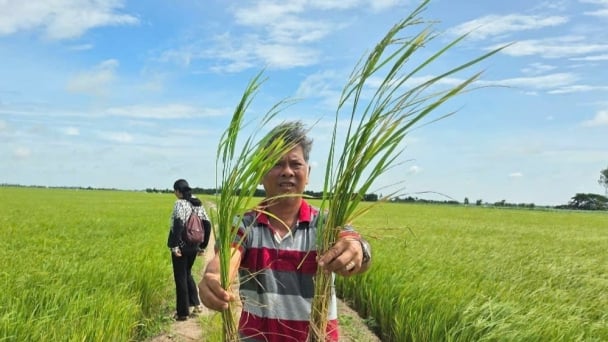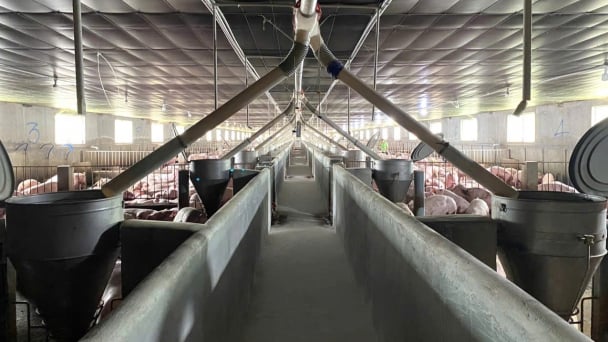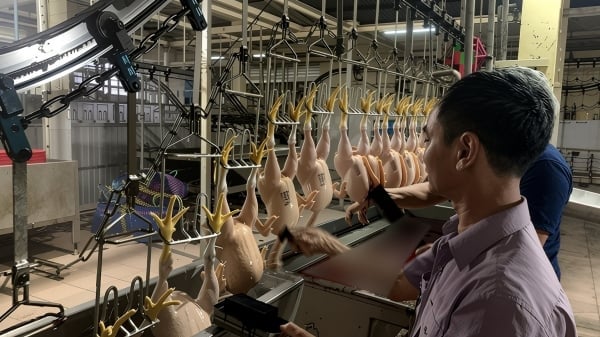August 31, 2025 | 10:04 GMT +7
August 31, 2025 | 10:04 GMT +7
Hotline: 0913.378.918
August 31, 2025 | 10:04 GMT +7
Hotline: 0913.378.918
At nearly 90 years old, Prof. Dr. Phan Sy Ky still works tirelessly day and night on construction design drawings and provides technical consultancy to the Ministry of Agriculture and Rural Development (now the Ministry of Agriculture and Environment) for large-scale irrigation structures with complex engineering requirements. According to him, these are extremely difficult projects to execute, requiring enormous investment rates.
For nearly 30 years since his retirement, he has remained virtually "invisible" to the media, devoting all his energy to specialized irrigation research projects. On the eve of a special event, Vietnam Agriculture and Nature Newspaper had the opportunity to listen to his reflections on the remarkable "milestones" in the outstanding development of irrigation construction science and technology in Vietnam, particularly in the field of dams and reservoirs.

Prof. Dr. Phan Sy Ky, former Deputy Minister of Agriculture and Rural Development, shares about the remarkable breakthroughs in building irrigation structures in Vietnam. Photo: Dong Thai.
According to Prof. Dr. Phan Sy Ky, Vietnam's irrigation sector ranks among the world's leaders in terms of investment rate and irrigated and water-supplied area. This achievement is thanks to the large contribution of the construction sector.
Prior to 1995, most irrigation structures in Vietnam were relatively simple, consisting mainly of earth canals and earth dams. It is almost unimaginable that within just two decades, a series of monumental concrete dams and reservoirs were built, equipped with modern construction technologies and equipment. "These structures have given Vietnam's irrigation sector a new stature and a new position," reflected former Deputy Minister Phan Sy Ky.
After a lifetime of sticking with the sector, when he left the Ministry of Agriculture and Rural Development in 1997, the former Deputy Minister's greatest wish was for Vietnam's irrigation sector to develop projects comparable to those of other countries, or at least on par with Thailand. At that time, even neighboring Laos had irrigation structures ahead of Vietnam, funded by foreign investment.
By the early 2000s, easy irrigation structures had already been completed. The remaining projects were all difficult in terms of techniques and required enormous investment rates. Many works that they previously never dared to imagine possible have existed, demonstrating the maturity, capacity, and elevated position of the irrigation construction sector.

Ban Lai reservoir was built with roller-compacted concrete, enabling completion eight months ahead of schedule. Photo: DT.
A typical example is the Ban Lai Reservoir project in Lang Son province. Prof. Dr. Phan Sy Ky recalled, "In 1967, together with irrigation experts, I conducted topographical and geological surveys to develop an alignment plan for the Ban Lai Reservoir on the Ky Cung River in Lang Son province. However, after three years of exploratory drilling, the project was suspended, partly because of a lack of funding and partly because the geology at the dam site was too complex, consisting mainly of shale and sandstone. Moreover, to build an earth dam of several tens of millions of m³ would have required the use of soil from all surrounding fields."
It took half a century for the project to be restarted. Thanks to the application of roller-compacted concrete (RCC) technology in dam construction, the project was completed eight months ahead of schedule. The reservoir, with a capacity of 164.3 million m³, is now one of the largest in Northern Vietnam’s mountainous region.
"One of the most important imprints of the construction sector over the past two decades has been the formation of new mindsets. In the past, irrigation structures were built for a single province or district. Today, many are designed on an inter-provincial or regional scale, transferring water from surplus to deficit areas, from regions with abundant rainfall to those with little," said former Deputy Minister Phan Sy Ky.
He explained that it was impossible to convey water through open canals as in the past. Instead, irrigation structures must use closed-pipeline systems made of large-diameter steel or plastic, capable of withstanding high pressure to transport water across diverse and complex terrains.
A typical example is the transfer of water from the Song Cai reservoir to the Ba Rau, Song Trau, Cho Mo, and Ong Kinh reservoirs. The Tan My irrigation system even supplies additional water to southern Cam Ranh (Khanh Hoa province) while mitigating downstream floods and supporting aquaculture within the reservoir.

The Song Cai reservoir system (Ninh Thuan province), part of the Tan My irrigation system, is the longest RCC dam in Vietnam. Photo: DT.
According to the Politburo's Conclusion No. 36-KL/TW on ensuring water security and the safety of dams and reservoirs by 2030, with a vision to 2045, Vietnam must invest in the construction of freshwater storage works, as well as in regulating and distributing water resources within provinces, across provinces, across regions, and nationwide. In this regard, Vietnam has been performing well.
Particularly, Prof. Dr. Phan Sy Ky emphasized that one of the greatest achievements in irrigation construction in recent years has been the effective handling of compensation and resettlement. When building dams and reservoirs, the inundation area is vast, directly affecting the lives and livelihoods of residents in the flooded zones. The Politburo and the Prime Minister have consistently stressed that when relocating people, their new lives must be more secure, more prosperous, and more civilized than before.
In reality, however, many resettlement areas left people worse off than before. Without innovative thinking and dedication, this work would be nearly impossible to implement well. Building a house for residents is easy, but creating a happy, prosperous life for them is extremely difficult. That requires farmland, water, electricity, roads, schools, clinics, and cultural facilities. If resettlement simply means providing new houses, people will only come to receive the keys and then leave the homes locked.
In fact, the irrigation sector has done this work better than many others. Typically in the Dong Mit reservoir (Gia Lai) and Ngan Trui reservoir (Ha Tinh Province) projects, the construction of new resettlement villages was a mandatory technical requirement, even though compensation, relocation, and resettlement are officially the responsibility of local governments. Units under the Ministry of Agriculture and Rural Development had to closely supervise and press local governments to ensure resettlement was carried out properly, rather than limiting the Ministry’s role to merely receiving clean sites for project construction.
Regarding the aesthetics of irrigation projects built in recent years, Prof. Dr. Phan Sy Ky stated, "Each one is beautiful and of high quality, on par with, if not superior to, many major national projects." The Ministry of Agriculture and Rural Development (now the Ministry of Agriculture and Environment) has also consistently encouraged consultants and designers to pay close attention to aesthetics, turning irrigation works into scenic landscapes and symbols of rural renovation.
This mindset is entirely correct. Once a reservoir with vast water surfaces, forests, and natural ecosystems is in place, the next step should be to create an attractive, eye-catching project. If just VND 5–10 billion from an investment project worth thousands of billions is allocated to landscaping and enhancing the project’s aesthetics, the social and community value it brings will be extremely great.
In recent times, Vietnam's irrigation sector has built large-scale, impressive works across the country largely due to the Ministry's respect for talent and its willingness to listen to the advice of leading experts in each field. This has enabled the Ministry to adopt the most effective solutions.
Because not every suggestion has been accurate or constructive, personnel within the Ministry’s specialized agencies for construction management must possess deep expertise, vision, and courage, ready to take responsibility while advising and recommending to the leadership the most optimal, cost-saving, aesthetic, and effective solutions. Only by doing so can Vietnam maximize the benefits of its water resources for multi-sectoral and multi-purpose service.
Translated by Thu Huyen
/2025/08/30/5239-5-024833_424.jpg)
(VAN) With the construction of the 'great canal' to channel freshwater and irrigation sluice and dike systems, the once acidic and alum-contaminated lands of Dong Thap Muoi and the Long Xuyen Quadrangle have revived.
/2025/08/29/5326-0-nongnghiep-105322.jpg)
(VAN) From a few hundred million USD in the late 1990s, Vietnam's wood exports have soared to USD 15 billion in 2025, affirming its status as a global powerhouse in wood processing and furniture manufacturing.

Instead of burning, microbial technology helps farmers turn millions of tons of straw into organic fertilizer, saving costs and protecting the environment.
/2025/08/28/5450-5-164042_320.jpg)
(VAN) From the risk of complete forest loss after the war, Vietnam has restored forest cover to more than 42%, becoming an international bright spot in forestry and sustainable development.

(VAN) Facing the risk of ASF outbreaks, Tay Ninh has strengthened disease prevention, and many farms have set up 'biological shields' to stabilize production.

(VAN) With a high demand for livestock slaughter, the veterinary sector of Vinh Long has tightened control to prevent unsanitary food from entering the market.